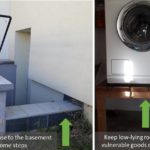Tool risk reduction measures
PREVENT DAMAGES
«The benefits of prevention are not tangible; they are the disasters that did not happen.»
Kofi Annan, former UN SG
What do you find here?

This section provides support, mainly for municipalities and private persons , to find out if a development area or a property might be at heavy rain flood risk, and if so, which measures can be taken in order to avoid or reduce the risk identified. Additionally, for existing settlement areas or properties already at risk of heavy rain, support is provided for finding helpful information and suitable protection measures. Moreover, regional administrations might additionally support municipalities and private persons e.g. by providing overarching information.
What is prevention, and how can it contribute to risk reduction?
Prevention measures in flood risk management are all those measures which can be taken in times without heavy rain events, in order to avoid or reduce the risk of possible damages or losses.
The focus of this section is on municipalities and on private persons, as those two actor groups are the ones with the presumably highest potential to reduce adverse consequences by protecting life, property and environment.
What can be done?
Find the basic steps and get further information:
Private persons can do a lot to protect themselves and their property from heavy rain flood damages. Houses and other buildings can be designed flood-resilient, existing houses with flood risk can be retrofitted in order to reduce future flood damages. Residents can develop a private alarm plan and ensure financial security, e.g. by taking out a flood insurance policy.
Public municipal administrations are responsible for the development of the municipality. They are the key actors to collect available heavy rain risk information, to close information gaps, to steer flood safe housing and infrastructure development, to initiate community measures for flood protection, to initiate emergency management planning for heavy rain flooding, and to provide information to the population.
Regional administrations are often responsible for providing information on higher-level issues such as e.g. floods. With regards to the rather local issue of heavy rain, some provide supporting material like informative brochures, technical guidelines and funding information to municipalities and private persons, therewith ensuring coordinated information, planning and risk reduction processes within their region.
...as private person




Step 1: Know your risks
Check your location:
- Is your property in a basin-shaped or sloped area with relevant portions of land lying above the future house or other buildings?
- Is your planned building lying in a depth contour or adjacent to a sloped street?
- Are there (dried up) watercourses nearby, and how do their water levels rise in or after heavy rain events?
- Is there a relevant proportion of soil sealing or soils with reduced infiltration capacity in the neighbourhood and will the future development worsen the current situation?
- Can water leak out of nearby sewage systems and flow to my property / future house?
- Will my future house be connected to the sewage system?
- Can heavy rain cause problems through overloaded roof drainage systems, yard drainage systems, or infiltration systems?
Each of these factors can contribute to heavy rain flooding.
Ask the previous land owners or current neighbours:
- Have there been reports on previous flood events?
- Are there frequently or longer lasting puddles, muddy areas or erosions after rain events on your property?
If so, heavy rain flooding might be an issue.
Plan the built structures: Generally, you are obliged not to worsen the flooding situation for your neighbours. Therefore, you should plan the built structures (main house, auxiliary buildings, pavements, fences and enclosures) on your property such that (i) heavy rain water can follow its natural discharge paths on the surface, from the upper flow entrances to your property to the lower flow outlets on your property, (ii) the water flow velocity on your property remains as before or better be decreased, (iii) the amount of rain water discharged to the lower flow outlets remains as before or is better being decreased e.g. by new infiltration measures.
Check web portals: EU member states have produced official flood hazard and risk maps, mainly for river flooding, but recently also for flooding from heavy rain. Other official maps might be obtained from federal portals for natural hazards or from water management adminstrations. This official information can be assessed as valid and reliable. Besides this, other products might be publicly available as well, maybe coming from academic institutions, cooperations, or technical offices. This information could be assessed as indicative. A collection of links to available web information is provided in the boxes below.
Ask your municipality: Nothing found online? Then ask your municipality: they might have general natural hazards maps, or specific heavy rain flood maps, or other plans addressing heavy rain flood issues like e.g. hazard zone plans. Otherwise they might know where such information can be obtained.
How to read and use flood maps: flood maps usually display one or more of the following information: hazard or risk areas, flow paths, flooded areas, water depths, flow velocities. If you can identify your property, then you can assess whether a heavy rain risk is assigned to it or not.
READ MORE
- Governmental indicative heavy rain hazard map for Austria
- National platform for natural hazard overview and risk assessment for Austria
- State Hydrographic Services Website for statistical and historical precipitation data, incl nowcasting services, based on station data
- Central Institution for Meteorology and Geodynamics Website for precipitation nowcasting and historical data, based on radar data
- Styrian GIS-Portal for waters and water information
- Styrian GIS-Portal for spatial information
- Regional flow path map from Lower Austria
- Case study Upper Austria: heavy rain hazard map
- Municipal flow path map of Graz (City of Graz)
- National map with heavy rain flow paths and critical points
- Official Hydrometeorological Institute portal with flood nowcasting, forecasting, and alert services
- Official Hydrometeorological Institute portal with natural hazards alert information
- Official Hydrometeorological Institute portal with actual precipitation radar data
- Official water management information portal a.o. with station precipitation data
- National topographical map with detailed digital relief model
- Fairytales for children on responsible handling of rainwater issues
In Germany information is sometimes offered on national level, but also frequently offered on the federal state level, and sometimes even on the municipal level. Therefore the link list below contains a selection of examples which are – from the RAINMAN perspective – considered as current good-practice.
If you want to know your risk, you might find information on federal state level regarding flood forecast information, early warning, topographical information, guidance for assessing and mapping of heavy rain risks. The heavy rain hazard and risk maps are often available on the municipal level.
- State German weather Service (DWD) website for precipitation data, statistics, now- and forecasting services
- Website by the insurance industry with risks maps for different natural hazards for parts of Germany
- Official Saxonian Flood Center Website with nowcasting and forecasting information and early warning
- Official Saxonian topographical maps
- Official Saxonian digital elevation model
- Case study Glems catchment area – heavy rain hazard maps with inter-municipal cooperation of eight municipalities in Baden-Wurttemberg
- City of Cologne Website with heavy rain hazard and risk maps
- Official Baden-Wurttemberg website with guidance on heavy rain risk assessment and mapping for municipalities, incl funding
- Official North-Rhine-Westphalia website with guidance on heavy rain risk assessment and mapping for municipalities
- City of Bremen website for climate adaptation strategies
- Polish meteorological service: portal for weather nowcast, forecast, radar maps, historical data
- Polish meteorological service: climate data
- Polish meteorological service: station data
- Institute of Meteorology and Water Management-National Research Institute (IMGW-PIB): official design precipitation values upon request
- Polish meteorological service: precipitation forecast for the next two hours for Poland
- Topographical map
Get some insights on how other countries, which were not involved in RAINMAN, are approaching heavy rain risk assessment and mapping:
Belgium:
The Netherlands:
- National heavy rain hazard map, with water depth for two different precipitation events (70mm in 2 hours and 140 mm in 2 hours)
- National now-casting precipitation service
- Online archive of precipitation data (GIS interface)
United Kingdom:




The tool ASSESSMENT and MAPPING provides further information on how to assess and display your hazard and risks.




Step 2: Prevent damages
Private persons can effectively protect themselves and their property from heavy rain flood damages. Houses and other buildings on the property can be built in places or designed such that
- ideally no heavy rain water flows to the building,
- ideally no heavy rain water can enter the building, or
- flood-affected building parts are used in a way that entering water causes no damage.
Already existing houses with possible heavy rain flood risk can be retrofitted by technical measures in order to reduce or eliminate future damages, e.g.
- flood barriers can be installed to prevent water from entering the building
- the use of flood-affected building parts can be changed in a way that entering water will cause no damage in the future
Moreover, natural measures like new retention areas or soil infiltration measures can be established on the property in order to reduce the water flowing on the surface.
Finally, preparation measures can be established, e.g. residents can develop a private alarm plan and ensure financial security, e.g. by taking out a flood insurance policy.
Experts like insurance companies, architect, flood protection systems planners / traders, municipality advisory services might be available in your area to support you in assessing your risks and finding appropriate measures.
READ MORE
- Governmental manual on self protection measures for floods
- Official weather alerts from the Central Institute for Meteorology and Geodynamics
- Governmental alert system for emergency situations
- Upper Austrian civil protection information for heavy rain
- Official Styrian website on self protection measures for floods
- Official Styrian guidance for surface drainage in building approval proceedings
- Brochure from agricultural chamber of Upper Austria on good professional practice for water protection
- City of Graz portal with information for flood adapted planning and construction
- City of Graz Andritz and St. Peter brochure for for private action before, during and after floods
- City of Graz Brochure on self protection for floods
- Brochures for water resistant planning and construction from Austrian Water and Waste Management Association
- Czech Hydrometeorological Institute website with reporting and flood forecasting service
- South Bohemian Region information materials for private protection against heavy rain floods
- Brochure with instructions for flood victims from Prague NGO
- Instructions for behaviour in torrential floods
- Czech project website on stormwater management for public authorities and technical planners
- Ministry of Environment Catalogue on natural based solutions for water retention in the landscape
- National website on standards for good agricultural and environmental soil conditions
- Water research institute webpage on erosion and rainwater flood mitigation through nature-based solutions
- Archive from Czech public forest management research institute with guidelines for water management in forest soils
- Czech fire brigade portal with seminar report on emergency management for municipalities
In Germany information is sometimes offered on national level, but also frequently offered on the federal state level, and sometimes even on the municipal level. Therefore the link list below contains a selection of examples which are – from the RAINMAN perspective – considered as current good-practice.
If you want to prevent damages, natural hazard information is often found on federal state levels, the same applies to general guidelines for private protection or municipal measures. In some cases, city websites also contain heavy rain information for prevention.
- Official weather alerts app from German Weather Services
- Nationwide Hazard Warning app from Scientific Research Institute
- Governmental hazard warning App from Federal Office of Civil Protection and Disaster Assistance, with weather and flood alerts
- Saxonian competence center website for private flood protection
- Official Saxonian natural hazards information website for private persons
- Informative portal from the insurance industry on private risk prevention for heavy rain
- Guideline on private protection measures against heavy rain, from municipal water disposal organisation of City of Cologne
- Brochure for heavy rain preventive planning and construction, from City of Leipzig water management
- City of Hamburg water management website for green and blue infrastructure and decentralized rainwater management
- Official weather alerts from Hungarian National Meteorological Service
- Guidance on blue and green infrastructure for rain water management in urban areas, for private properties and public space, from annex to Hungarian Danube river basin management plan
- Good agricultural practice for farmers from national chamber of agriculture
- Warsaw Case study for sustainable use of surface and rainwater, from Sustainability foundation
- City of Lodz case study for small retention program
- Lodz infrastructure Brochure for rainwater retention on property level
- Official Guidebook for erosion protection
- Instructional brochures on increasing landscape retention from sustainability foundation
- Project guideline for erosion reduction measures in mountain regions
- Project guideline for runoff and erosion management in agricultural areas
Get some insights on how other countries, which were not involved in RAINMAN, are approaching prevention of damages from heavy rain:
Belgium:
- Official collection of self protection measures for private properties against floods
- Official self protection measures for private properties and an interactive test to determine the influence of new buildings on the water system
- Official information on flood prevention and protection
The Netherlands:
- Collection of measures to increase infiltration on private properties
- Awareness raising for self protection measures in case of flooding for general public
- Iniative to reduce paved surfaces in gardens and public areas
United Kingdom:




The RAINMAN-Toolbox provides a comprehensive overview over possible measures: Browse through our CATALOGUE OF 100 RISK REDUCTION MEASURES
...as municipality




Step 1: Know your risks
Meteorological characteristics: Check with the hydrographical services of your region the precipitation characteristics of the area in question. If there is high annual precipitation, a high probability of heavy rain events, or experience with past floodings from heavy rain, then you might have an issue.
Location characteristics:
Ask yourself or an experienced local expert the following questions:
- Is the area basin-shaped or sloped with relevant portions of land lying above the future development area?
- Are there (dried up) watercourses nearby, and how do water levels rise in or after heavy rain events?
- Is there a relevant proportion of soil sealing or soils with reduced infiltration capacity in the area and will the land development worsen the current situation in the area itself or in neighbouring areas?
Each of these factors can contribute to heavy rain flooding.
Ask the current land owners or current neighbours in the area:
- Have there been reports on previous flood events?
- Are there frequently or longer lasting puddles, muddy areas or erosions after rain events?
If so, heavy rain flooding might be an issue.
Get information: Ask your higher authority (e.g. regional administration) for spatial planning for regional spatial plans or regional development plans in which heavy rain risk is accounted for. Ask your higher authority (e.g. regional administration) for water management for available heavy rain hazard mapping information.
How to use the information: Local planning instruments should take the regionally available information into account, such that future infrastructures and buildings can be placed and designed resilient against heavy rain floods. If possible, official building regulations could additionally request future house owners to build in a flood resilient manner. Additionally, the local planning should be designed such that the already existing risks for existing infrastructures and buildings do not increase.
How to assess / quantify heavy rain hazards: Usually, water management experts can provide heavy rain hazard information, based upon computer simulation results. Results like flow paths or flooded areas, water depths, and flow velocities can provide the necessary information for municipality planning and protection measures. See also the RAINMAN mapping tool for further information to this subject.
Which external factors can change the risk? Generally, climate change effects will change the meteorological precipitation characteristics, but also changes in the location characteristics like earthworks (e.g. dams, underpasses), land use changes (e.g. from forest to farmland), soil sealing processes (e.g. new streets, new buildings), disadvantageous agricultural uses (crops, soil cultivation practices) can aggravate heavy rain risks. Anticipatory planning could account for future consequences from expected changes.
READ MORE
- Governmental indicative heavy rain hazard map for Austria
- National platform for natural hazard overview and risk assessment for Austria
- Website for statistical and historical precipitation data, incl nowcasting services, based on station data
- Website for precipitation nowcasting and historical data, based on radar data
- Styrian GIS-Portal for waters and water information
- Styrian GIS-Portal for spatial information
- Regional flow path map from Lower Austria
- Case study Upper Austria: heavy rain hazard map
- Municipal flow path map of Graz (City of Graz)
- Croatian Meteorological and Hydrological Institute website with precipitation now-casting service
- Croatian Meteorological and Hydrological Institute website with data services
- Publications from the Croatian Meteorological and Hydrological Institute
- National water management authority portal from Croatian Waters
- National map with heavy rain flow paths and critical points
- Official Hydrometeorological Institute portal with flood nowcasting, forecasting, and alert services
- Official Hydrometeorological Institute portal with natural hazards alert information
- Official Hydrometeorological Institute portal with actual precipitation radar data
- Official Hydrometeorological Institute website with basic precipitation information and historical data
- Official Hydrometeorological Institute website with time series data
- Official water management information portal a.o. with station precipitation data
- National topographical map with detailed digital relief model
- Fairytales for children on responsible handling of rainwater issues
In Germany information is sometimes offered on national level, but also frequently offered on the federal state level, and sometimes even on the municipal level. Therefore the link list below contains a selection of examples which are – from the RAINMAN perspective – considered as current good-practice.
If you want to know your risk, you might find information on federal state level regarding flood forecast information, early warning, topographical information, guidance for assessing and mapping of heavy rain risks. The heavy rain hazard and risk maps are often available on the municipal level.
- State German weather Service (DWD) website for precipitation data, statistics, now- and forecasting services
- Website by the insurance industry with risks maps for different natural hazards for parts of Germany
- Official Saxonian Flood Center Website with nowcasting and forecasting information and early warning
- Official Saxonian topographical maps
- Official Saxonian digital elevation model
- Official Baden-Wurttemberg website with guidance on heavy rain risk assessment and mapping for municipalities, incl funding
- Regional Board Stuttgart, Germany: interactive example of a heavy rain hazard and risk assessment for a municipality: Regina Stark’s task
- City of Cologne Website with heavy rain hazard and risk maps
- Polish meteorological service: portal for weather nowcast, forecast, radar maps, historical data
- Polish meteorological service: climate data
- Polish meteorological service: station data
- Institute of Meteorology and Water Management-National Research Institute (IMGW-PIB): official design precipitation values upon request
- Polish meteorological service: precipitation forecast for the next two hours for Poland
- Topographical map
Get some insights on how other countries, which were not involved in RAINMAN, are approaching heavy rain risk assessment and mapping:
Belgium:
- Official precipitation nowcast and forecast
- Meteorological service website on ongoing projects related to heavy rain
The Netherlands:
- National heavy rain hazard map, with water depth for two different precipitation events (70mm in 2 hours and 140 mm in 2 hours)
- Online archive of precipitation data (GIS interface)
- Regionalised hourly precipitation time series based on long term time series
United Kingdom:
Let the RAINMAN experineces guide you…
Please find further information on the experiences and lessons-learned in heavy rain risk assessment and mapping in different pilot regions in tool ASSESSMENT AND MAPPING.
Different studies and guideline were developed within RAINMAN. E.g.
- Instruction Manual on Sound Hydrodynamic Modelling of Heavy Rain Surface Flow for Technical Experts and Administrations and
- Technical Report “Structural Effects in Hydrodynamic Surface Flow Modelling for Heavy Rain Risk Assessment Using Different Software”
University of Innsbruck, Unit of Hydraulic Engineering; Environment Agency Austria, Surface Waters Team; Federal Office of Upper Austria, Flood Protection Group - Guideline on Model-based urban flood provision,
Graz University of Technology, Institute of Urban Water Management and Landscape Water Engineering, Office of the Styrian Government, Department 14 Water Management, Resources and Sustainability
You can find more in our Downloads page.




The tool ASSESSMENT and MAPPING provides further information on how to assess and display your hazard and risks.




Step 2: Prevent damages
Municipal administrations are responsible for the development of the municipality. They can steer a flood safe housing and infrastructure development, and initiate community measures for better flood protection.
- Local land use planning measures can be used to e.g. keep hazardous areas free of building and infrastructure developments, or to adapt the land use such that heavy rain events cannot cause damages to valuable assets.
- Legal measures like e.g. official requirements for new buildings can be used to enforce constructions which ensure that heavy rain events cannot cause damages.
- Natural measures like e.g. creation of natural heavy rain retention areas or adaptation of agricultural practices can help to keep heavy rain water and eroded soils away from vulnerable buildings and infrastructures
- Technical measures like e.g. flood barriers or elevated floors can help to make buildings or infrastructures resilient against heavy rain events, or to reduce possible damages
- Other measures like e.g. awareness raising activities can help to make citizens aware of possible heavy rain risks, and can encourage them to take self-protection measures
By involving other experts and stakeholders like e.g. sewage system experts, emergency response teams, responsible persons for traffic or social issues, forest owners or farmers, future property owners, planners, a comprehensive coordination of future development can take place and an integrated concept for heavy rain mitigation measures can be achieved.
READ MORE
- Governmental manual on self protection measures for floods
- Official weather alerts from the Central Institute for Meteorology and Geodynamics
- Governmental alert system for emergency situations
- Upper Austrian civil protection information for heavy rain
- Office of the Upper Austrian Government, 2015: management of pluvial floods – catalogue of measures (unpublished brochure, online version accessible)
- Official Styrian website on self protection measures for floods
- Official Styrian guidance for surface drainage in building approval proceedings
- Brochure from agricultural chamber of Upper Austria on good professional practice for water protection
- City of Graz portal with information for flood adapted planning and construction
- City of Graz Andritz and St. Peter brochure for for private action before, during and after floods
- City of Graz Brochure on self protection for floods
- Brochures for water resistant planning and construction from Austrian Water and Waste Management Association
- Czech official technical standard for rainwater management
- Czech Hydrometeorological Institute website with reporting and flood forecasting service
- South Bohemian Region information materials for private protection against heavy rain floods
- Brochure with instructions for flood victims from Prague NGO
- Instructions for behaviour in torrential floods
- Czech project website on stormwater management for public authorities and technical planners
- Ministry of Environment Catalogue on natural based solutions for water retention in the landscape
- National website on standards for good agricultural and environmental soil conditions
- Water research institute webpage on erosion and rainwater flood mitigation through nature-based solutions
- Archive from Czech public forest management research institute with guidelines for water management in forest soils
- Czech fire brigade portal with seminar report on emergency management for municipalities
In Germany information is sometimes offered on national level, but also frequently offered on the federal state level, and sometimes even on the municipal level. Therefore the link list below contains a selection of examples which are – from the RAINMAN perspective – considered as current good-practice.
If you want to prevent damages, natural hazard information is often found on federal state levels, the same applies to general guidelines for private protection or municipal measures. In some cases, city websites also contain heavy rain information for prevention.
- Official weather alerts app from German Weather Services
- Nationwide Hazard Warning app from Scientific Research Institute
- Governmental hazard warning App from Federal Office of Civil Protection and Disaster Assistance, with waether and flood alerts
- Official Baden-Wurttemberg website for flood prevention
- Heavy rain management measures for municipalities from Rhineland-Palatine and Baden-Wurttemberg federal governments
- Guideline on private protection measures against heavy rain, from water provider of City of Bremen
- City of Hamburg water management website for green and blue infrastructure and decentralized rainwater management
- German Industry Standard (DIN) with design, construction, operation and maintenance provisions of drainage systems for the discharge of wastewater in buildings and on land
- Official weather alerts from Hungarian National Meteorological Service
- Guidance on blue and green infrastructure for rain water management in urban areas, for private properties and public space, from annex to Hungarian Danube river basin management plan
- Municipal flood damage prevention plan, from national chamber of water management engineers
- Good agricultural practice for farmers from national chamber of agriculture
- Warsaw Case study for sustainable use of surface and rainwater, from Sustainability foundation
- Report on blue-green infrastructure for climate change mitigation in cities, from Sustainability foundation
- City of Lodz case study for small retention program
- Lodz infrastructure Brochure for rainwater retention on property level
- Official Guidebook for erosion protection
- Instructional brochures on increasing landscape retention from sustainability foundation
Get some insights on how other countries, which were not involved in RAINMAN, are approaching prevention of damages from heavy rain:
Belgium:
- Official collection of self protection measures for private properties against floods
- Official self protection measures for private properties and an interactive test to determine the influence of new buildings on the water system
- Official information on flood prevention and protection
- Retention measures for public areas in Flanders
- Climate change impacts and adaptation measures for the water sector
The Netherlands:
- Collection of measures to increase infiltration on private properties
- Awareness raising for self protection measures in case of flooding for general public
- Guideline for regional administrations to investigate how much rain water can be stored on private properties
- Guideline for water management on private properties
- Iniative to reduce paved surfaces in gardens and public areas
- Mind map of possible effects of climate change on water related subjects in the Netherlands
- Guideline for water management in agriculture and nature conservation
United Kingdom:
- What to do in a flood event, incl. further links
- UK guidance on requirements for storm water drainage design for new developments
- Guideline on green infrastructure (UK green building council)
- Glasgow planning guidance for developers: flood risk assessment and drainage impact assessment (City of Glasgow)
- Research results for flood mitigation measures in forestry practice
Let the RAINMAN experience guide you…
The Tool RISK REDUCTION MEASURES provides many approaches to reducing the risks of a heavy rain event. Hereby, different strategies for risk reduction should be combined while taking different fields of action into account. E.g.
- Organise emergency response: Adapt your emergency response to heavy rain risks
- Retain rainwater: Learn about different retention concepts
- Adapt spatial planning: Learn about the risk reduction possibilities of different planning instruments
Communication of risks and thereby raising awareness are also important precautionary components of an integrated heavy rain risk management.




The RAINMAN-Toolbox provides a comprehensive overview over possible measures: Browse through our CATALOGUE OF 100 RISK REDUCTION MEASURES
...as regional administration




Step 1: Know your risks
Regional administrations are often responsible for providing regional information on higher-level issues such as e.g. floods. Heavy rain flooding is addressed in the EU Floods Directive, and in its actual second implementation cycle, the Member States are encouraged to include pluvial flooding into their risk assessment, mapping and plan of measures. As the considerations of this source of flooding has started around 2015, in 2019 only few national / regional approaches are available, and several methods for risk assessment and mapping can be found in different Member States. RAINMAN provides a collection of available administrative approaches, own experimental studies, and experiences and guidelines for numerical simulations of pluvial flooding.
READ MORE
- Governmental indicative heavy rain hazard map for Austria
- National platform for natural hazard overview and risk assessment for Austria
- Website for statistical and historical precipitation data, incl nowcasting services, based on station data
- Website for precipitation nowcasting and historical data, based on radar data
- Styrian GIS-Portal for waters and water information
- Styrian GIS-Portal for spatial information
- Regional flow path map from Lower Austria
- Case study Upper Austria: heavy rain hazard map
- Municipal flow path map of Graz (City of Graz)
- Croatian Meteorological and Hydrological Institute website with precipitation now-casting service
- Croatian Meteorological and Hydrological Institute website with data services
- Publications from the Croatian Meteorological and Hydrological Institute
- National water management authority portal from Croatian Waters
- National map with heavy rain flow paths and critical points
- Official Hydrometeorological Institute portal with flood nowcasting, forecasting, and alert services
- Official Hydrometeorological Institute portal with natural hazards alert information
- Official Hydrometeorological Institute portal with actual precipitation radar data
- Official Hydrometeorological Institute website with basic precipitation information and historical data
- National topographical map with detailed digital relief model
- Fairytales for children on responsible handling of rainwater issues
In Germany information is sometimes offered on national level, but also frequently offered on the federal state level, and sometimes even on the municipal level. Therefore the link list below contains a selection of examples which are – from the RAINMAN perspective – considered as current good-practice.
If you want to know your risk, you might find information on federal state level regarding flood forecast information, early warning, topographical information, guidance for assessing and mapping of heavy rain risks. The heavy rain hazard and risk maps are often available on the municipal level.
- State German weather Service (DWD) website for precipitation data, statistics, now- and forecasting services
- Official Saxonian Flood Center Website with nowcasting and forecasting information and early warning
- Official Saxonian topographical maps
- Official Saxonian digital elevation model
- Case study Glems catchment area – heavy rain hazard maps with inter-municipal cooperation of eight municipalities in Baden-Wurttemberg
- Official Baden-Wurttemberg website with guidance on heavy rain risk assessment and mapping for municipalities, incl funding
- Regional Board Stuttgart, Germany: interactive example of a heavy rain hazard and risk assessment for a municipality: Regina Stark’s task
- Official North-Rhine-Westphalia website with guidance on heavy rain risk assessment and mapping for municipalities
- City of Bremen website for climate adaptation strategies
- Polish meteorological service: portal for weather nowcast, forecast, radar maps, historical data
- Polish meteorological service: climate data
- Polish meteorological service: station data
- Institute of Meteorology and Water Management-National Research Institute (IMGW-PIB): official design precipitation values upon request
- Polish meteorological service: precipitation forecast for the next two hours for Poland
- Topographical map
Get some insights on how other countries, which were not involved in RAINMAN, are approaching heavy rain risk assessment and mapping:
Belgium:
- Heavy rain hazard map for Flanders with flooded areas
- Official precipitation nowcast and forecast
- Meteorological service website on ongoing projects related to heavy rain
The Netherlands:
- National heavy rain hazard map, with water depth for two different precipitation events (70mm in 2 hours and 140 mm in 2 hours)
- Regionalised hourly precipitation time series based on long term time series
- Collection of different types of design precipitation
United Kingdom:
Let the RAINMAN experineces guide you…
Please find further information on the experiences and lessons-learned in heavy rain risk assessment and mapping in different pilot regions in tool ASSESSMENT AND MAPPING.
Different studies and guideline were developed within RAINMAN. E.g.
- Instruction Manual on Sound Hydrodynamic Modelling of Heavy Rain Surface Flow for Technical Experts and Administrations and
- Technical Report “Structural Effects in Hydrodynamic Surface Flow Modelling for Heavy Rain Risk Assessment Using Different Software”
University of Innsbruck, Unit of Hydraulic Engineering; Environment Agency Austria, Surface Waters Team; Federal Office of Upper Austria, Flood Protection Group - Guideline on Model-based urban flood provision,
Graz University of Technology, Institute of Urban Water Management and Landscape Water Engineering, Office of the Styrian Government, Department 14 Water Management, Resources and Sustainability
You can find more in our Downloads page.




The tool ASSESSMENT and MAPPING provides further information on how to assess and display your hazard and risks.




Step 2: Prevent damages
Compared to fluvial flooding, heavy rain flood risk is rather a local issue. However, considering climate change effects and the progressing land consumption and soil sealing, regional planning and risk mitigation measures for enhanced soil infiltration and distributed retention will gain increasing attention. Furthermore, integrative planning with several stakeholders will gain importance for the crosscutting subject of heavy rain.
READ MORE
- Governmental manual on self protection measures for floods
- Official weather alerts from the Central Institute for Meteorology and Geodynamics
- Governmental alert system for emergency situations
- Upper Austrian civil protection information for heavy rain
- Office of the Upper Austrian Government, 2015: management of pluvial floods – catalogue of measures (unpublished brochure, online version accessible)
- Official Styrian website on self protection measures for floods
- Official Styrian guidance for surface drainage in building approval proceedings
- Brochure from agricultural chamber of Upper Austria on good professional practice for water protection
- Czech official technical standard for rainwater management
- Czech Hydrometeorological Institute website with reporting and flood forecasting service
- Brochure with instructions for flood victims from Prague NGO
- Instructions for behaviour in torrential floods
- Czech project website on stormwater management for public authorities and technical planners
- Ministry of Environment Catalogue on natural based solutions for water retention in the landscape
- National website on standards for good agricultural and environmental soil conditions
- Water research institute webpage on erosion and rainwater flood mitigation through nature-based solutions
- Archive from Czech public forest management research institute with guidelines for water management in forest soils
- Czech fire brigade portal with seminar report on emergency management for municipalities
In Germany information is sometimes offered on national level, but also frequently offered on the federal state level, and sometimes even on the municipal level. Therefore the link list below contains a selection of examples which are – from the RAINMAN perspective – considered as current good-practice.
If you want to prevent damages, natural hazard information is often found on federal state levels, the same applies to general guidelines for private protection or municipal measures. In some cases, city websites also contain heavy rain information for prevention.
- Official weather alerts app from German Weather Services
- Nationwide Hazard Warning app from Scientific Research Institute
- Governmental hazard warning App from Federal Office of Civil Protection and Disaster Assistance, with waether and flood alerts
- Official Baden-Wurttemberg website for flood prevention
- Heavy rain management measures for municipalities from Rhineland-Palatine and Baden-Wurttemberg federal governments
- Guideline on private protection measures against heavy rain, from water provider of City of Bremen
- German Industry Standard (DIN) with design, construction, operation and maintenance provisions of drainage systems for the discharge of wastewater in buildings and on land
- Official weather alerts from Hungarian National Meteorological Service
- Guidance on blue and green infrastructure for rain water management in urban areas, for private properties and public space, from annex to Hungarian Danube river basin management plan
- Municipal flood damage prevention plan, from national chamber of water management engineers
- Good agricultural practice for farmers from national chamber of agriculture
Get some insights on how other countries, which were not involved in RAINMAN, are approaching prevention of damages from heavy rain:
Belgium:
- Retention measures for public areas in Flanders
- Climate change impacts and adaptation measures for the water sector
The Netherlands:
- Guideline for regional administrations to investigate how much rain water can be stored on private properties
- Guideline for water management on private properties
- Mind map of possible effects of climate change on water related subjects in the Netherlands
- Guideline for water management in agriculture and nature conservation
- Agricultural measures for climate adaptation in Brabant
United Kingdom:
- UK guidance on requirements for storm water drainage design for new developments
- Guideline on green infrastructure (UK green building council)
- Glasgow planning guidance for developers: flood risk assessment and drainage impact assessment (City of Glasgow)
- Research results for flood mitigation measures in forestry practice
Let the RAINMAN experience guide you…
The Tool RISK REDUCTION MEASURES provides many approaches to reducing the risks of a heavy rain event. Hereby, different strategies for risk reduction should be combined while taking different fields of action into account. E.g.
- Organise emergency response: Adapt your emergency response to heavy rain risks
- Retain rainwater: Learn about different retention concepts
- Adapt spatial planning: Learn about the risk reduction possibilities of different planning instruments
Communication of risks and thereby raising awareness are also important precautionary components of an integrated heavy rain risk management.




The RAINMAN-Toolbox provides a comprehensive overview over possible measures: Browse through our CATALOGUE OF 100 RISK REDUCTION MEASURES
OUR STORIES
Heavy Rain Adapted House Design is nothing new: effective prevention by local architect in the late sixties - Example from Lower Austria


Look at the old houses in our hilly landscape in Lower Austria: the local architects in the past already knew how to plan heavy rain safe houses: barrier-free openings on those sides of the house where the terrain is descending; no low-lying openings on sides of the house where the terrain is ascending. The house on the pictures is about 50 years old and was planned by a local building master. This is simply best practice! (Dr. Yvonne Spira, Environmental Agency Austria)








